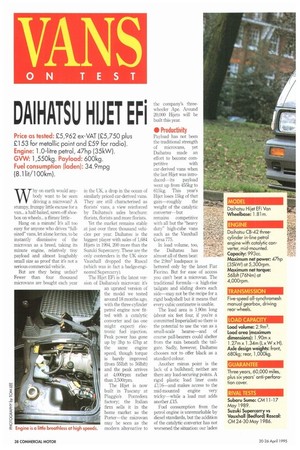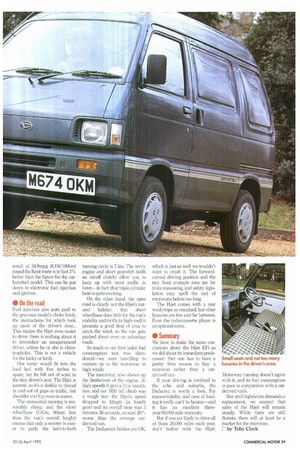DAIHATSU HIJET EFI
Page 40

Page 41

If you've noticed an error in this article please click here to report it so we can fix it.
Price as tested: £5,962 ex-VAT (£5,750 plus £153 for metallic paint and £59 for radio). Engine: 1.0-litre petrol, 47hp (35kW). GVW: 1,550kg. Payload: 600kg.
Fuel consumption (laden): 34.9mpg (8.114/100km).
Why on earth would anybody want to be seen driving a microvan? A stumpy, frumpy lithe excuse for a van.., a half-baked, sawn-off shoebox on wheels... a flimsy little
Hang on a minute! It's all too easy for anyone who drives "fullsized" vans, let alone lorries, to be instantly dismissive of the microvan as a breed, taking its minute engine, relatively tiny payload and almost laughably small size as proof that it's not a serious commercial vehicle.
But are they being unfair? Fewer than four thousand microvans are bought each year in the UK, a drop in the ocean of similarly priced car-derived vans. They are still characterised as florists' vans, a view reinforced by Daihatsu's sales brochure: florists, florists and more florists.
Yet the market remains stable at just over three thousand vehicles per year. Daihatsu is the biggest player with sales of 1,684 Hijets in 1994, 200 more than the Suzuki Supercarry. These are the only contenders in the UK since Vauxhall dropped the Rascal (which was in fact a badge-engineered Supercarry).
The Hijet EFi is the latest version of Daihatsu's microvan: it's an uprated version of the model we tested around 18 months ago, with the three-cylinder petrol engine now fitted with a catalytic converter and (as one might expect) electronic fuel injection. Peak power has gone up by 3hp to 47hp at the same engine speed, though torque is barely improved (from 551bft to 561bft) and the peak arrives at 4,000rpm rather than 3,500rpm.
The Hijet is now built in Tuscany at Piaggio's Pontedera factory; the Italian firm sells it in the home market as the Porter—the microvan may be seen as the modern alternative to the company's threewheeler Ape. Around 20,000 Hijets will be built this year.
• Productivity
Payload has not been the traditional strength of microvans, yet Daihatsu made an effort to become com
petitive with car-derived vans when the last Hijet was introduced—its payload went up from 455kg to 615kg. This year's Hijet loses 15kg of that gain—roughly the weight of the catalytic converter—but
remains competitive with all but the "heavy duty" high-cube vans such as the Vauxhall Corsa 775.
In load volume, too, the Daihatsu has almost all of them beat: the 29m3 loadspace is bettered only by the latest Fiat Fiorino. But for ease of access you can't beat a microvan. The traditional formula—a high-rise tailgate and sliding doors each side—may not be the recipe for a rigid bodyshell but it means that every cubic centimetre is usable.
The load area is 1.90m long (about six feet four, if you're a committed Imperialist) so there is the potential to use the van as a small-scale hearse—and of course pall-bearers could shelter from the rain beneath the tailgate. Sadly, however, Daihatsu chooses not to offer black as a standard colour, Another minus point is the lack of a bulkhead; neither are there any load-securing points. A rigid plastic load liner costs £116—and makes access to the mid-mounted engine very tricky—while a load mat adds another .4:15.
Fuel consumption from the petrol engine is unremarkable by diesel standards, but the addition of the catalytic converter has not worsened the situation: our laden result of 34.9mpg (8.11it/100km) round the Kent route is in fact 3% better than the figure for the carburetted model. This can be put down to electronic fuel injection and ignition.
• On the road
Fuel injection also puts paid to the previous model's choke knob, the instructions for which took up most of the driver's door... This makes the Hijet even easier to drive: there is nothing about it to intimidate an inexperienced driver, unless he or she is claustrophobic. This is not a vehicle for the lanky or lardy.
Our tester would fit into the load bed with five inches to spare, but he felt out of scale in the tiny driver's seat, The Hijet is narrow, so its a dodclie to thread in and out of gaps in traffic, but shoulder and hip room is scarce.
The unassisted steering is reasonably sharp, and the short wheelbase (1.81m, 60mm less than the van's overall height) means that only a scooter is easier to park: the kerb-to-kerb turning circle is 7.4m. The revvy engine and short gearshift (with an on/off clutch) allow you to keep up with most traffic in town—in fact, that triple-cylinder beat is quite exciting.
On the other hand, the open road is clearly not the Hijet's natural habitat: that short wheelbase does little for the van's stability and (with its high roof) it presents a good deal of area to catch the wind, so the van gets pushed about even on suburban roads.
So much so our first laden fuel consumption test was abandoned—we were unwilling to venture on to the motorway in high winds.
The motorway also shows up the limitations of the engine. At high speeds it gets a little breathless, and our M20 hill climb was a tough test: the Hijet's speed dropped to 42mph (in fourth gear) and its overall time was 3 minutes 36 seconds, around 20% worse than the average carderived van.
The Daihatsu's brakes are OK, which is just as well: we wouldn't want to crash it. The forwardcontrol driving position and the tiny front crumple zone are far from reassuring, and safety legislation may spell the end of micTovans before too long.
The Hijet comes with a rear wash/wipe as standard, but other luxuries are few and far between. Even the radio/cassette player is an optional extra.
• Summary
We have to make the same conclusions about the Hijet EFi as we did about its immediate predecessor: that one has to have a pretty firm reason to buy a microvan rather than a carderived van.
If your driving is confined to the urbs and suburbs, the Daihatsu is worth a look. For manoevrability and ease of loading it really can't be beaten—and it has an excellent threeyear/60,000-mile warranty But if you are likely to drive all of those .20,000 miles each year, don't bother with the Hijet. Motorway running doesn't agree with it, and its fuel consumption is poor in comparison with a car• derived van's.
But until legislation demands a replacement, we suspect that sales of the Hijet will remain steady While there are still florists, there will at least be a market for the microvan.
E by Toby Clark




























































































